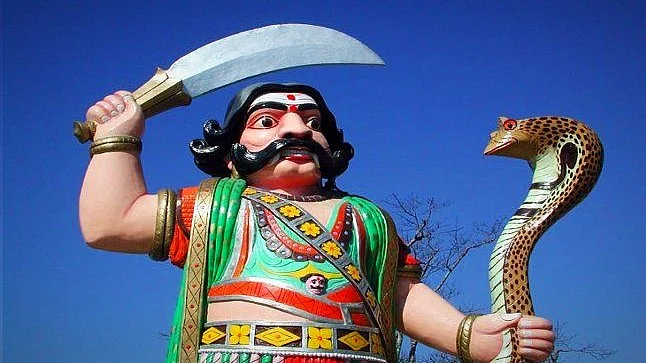As the battle between Devas and Asuras , the gods and demons in Indian mythology, raged on, one Asura had become a tough opponent for the Devas. Mahishasura, the buffalo demon, had two superpowers – he could shape-shift at will and no ‘man’ could ever kill him.
For the defeated and disheartened Devas, relief came in the form of Mahishasura Mardini (the killer of Mahisha), a reincarnation of goddess Durga, who killed him on the day of Dasara.
This is the mythological story behind Karnataka’s biggest festival – Mysuru Dasara. In the month of October, Mahishasura Mardini or Chamundeshwari is worshipped as part of the Dasara celebrations, led by the Mysuru royal family.
But the story behind Dasara is being contested by a group of rationalists in Karnataka.
The mythological story, according to them, is a misrepresentation of history. They claim Mahisha was not a demon, but a Buddhist ruler, who was murdered by upper caste Aryans. The story of a demon was created to discredit his legacy.
Mahisha Dasara, an alternative Dasara celebration organised by this rationalist group to promote this counter narrative, has now spiraled into a political controversy.
The Defenders of Mahishasura
Two armed police officers always accompany rationalist KS Bhagwan. This was after cops learnt that the group behind journalist Gauri Lankesh’s murder was planning to assassinate him for his rationalist views. Despite the threats, on 7 October, Bhagwan was at the forefront of the rally in Mysuru city, as part of the Mahisha Dasara.
The organisers of the rally, members of 20 rationalist outfits, demanded a change in the narrative claiming Mahisha to be a demon.
Their first argument is the name ‘Mysuru’. According to Bhagwan, the name ‘Mysuru’ is derived from Mahisha Mandala, which became Mahisuru, and finally, Mysuru. Mahishuru was named after erstwhile ruler of the region, Mahisha.
According to the organisers, the earliest mention of Mysuru in recorded history could be traced to 245 BC, where there are records of a team that was dispatched to Mahisha Mandala during Ashoka’s period after a Buddhist convocation to spread the word.
Talking to The Quint, Bhagwan said: “If he was such a demon, why would a place be named after him? He was a benevolent king and it was an upper caste conspiracy to portray him as a demon king,” he said.
A Monk, Not a Demon
At a short distance from the Chamundeshwari temple, in the heart of Mysuru, is a statue of an angry demon, holding sword and snake in his hand. Every year, before Dasara, the statue gets a fresh coat of paint, and for the tourists, a trip to Mysuru is incomplete without a photo next to this Mahishasura statue.
But during the Mahisha Dasara celebration, the group of progressive thinkers took out a rally to the statue. At the end of the rally, a decision was taken to write to the government demanding to replace the statue. Depicting a benevolent king, who looked beyond the caste system, as a demon is a mistake to be corrected, they demanded.
“We will be submitting a memorandum to the chief minister to replace the statue of the demon, which a misrepresentation, with a statue of a Buddhist monk. Mahisha was a follower of Buddha and a good ruler. He should not be projected as a demon.”KS Bhagwan
A Symbol of Alternate Narratives
The movement to clear Mahishasura’s name is not just about setting history straight; he has become a symbol of rebellion against the mythology of the privileged classes.
“Dark skinned, tribal from a lower caste, this has been identity of the demons in the mythology. This is such a Brahmin concept,” pointed a Dalit scholar from Mysuru University on condition of anonymity.
According to him, among many tribal communities, Durga puja or Dasara is a day of mourning as Mahishasura was considered a tribal king. “We have several history of non-Aryan narratives. Vamana is worshiped as an avatar of Vishnu in many parts of the country, but in Kerala, Mahabali, the Asura killed by Vamana, is considered the king of the land. But when Mahishasura is celebrated, the upper caste take offence, even now. Smriti Irani’s rant in the parliament is an example,” he pointed.
The Politics over Mahisha
The decision to celebrate Mahisha Dasara has kicked off a political controversy in Karnataka. Congress MLA and rationalist Satish Jarkiholi had given his support to the Mahisha Dasara celebrations, and had also participated in the rally.
“Mahisha was demonised because he belonged to the Shudra community. I will hold discussions with the people and academicians, and make a decision to make modifications to the Mahishasura statue atop Chamundi Hills. He was a Buddhist king who initiated many developmental projects in Mysuru,” he said at the Mysuru town hall during the Mahisha Dasara celebrations.
This, however, became a political issue when Mysuru BJP MP Pratap Simha called out the state government for not acting against the rally. Comparing the rally to the controversial Tipu Jayanthi, Simha said, “Kumarawamy must understand why Mahishasura Dasara must be stopped. These kinds of celebrations seriously hurt our religious sentiments. Besides, by celebrating someone who harassed the Mysuru rulers, it is an insult to the members of the royal family.”
The clashes over celebrating the birth anniversary of Muslim ruler Tipu Sultan had claimed two lives earlier this year. With the general election just around the corner, Mahishasura is feared to be the next topic of polarisation in the state.
(At The Quint, we question everything. Play an active role in shaping our journalism by becoming a member today.)
